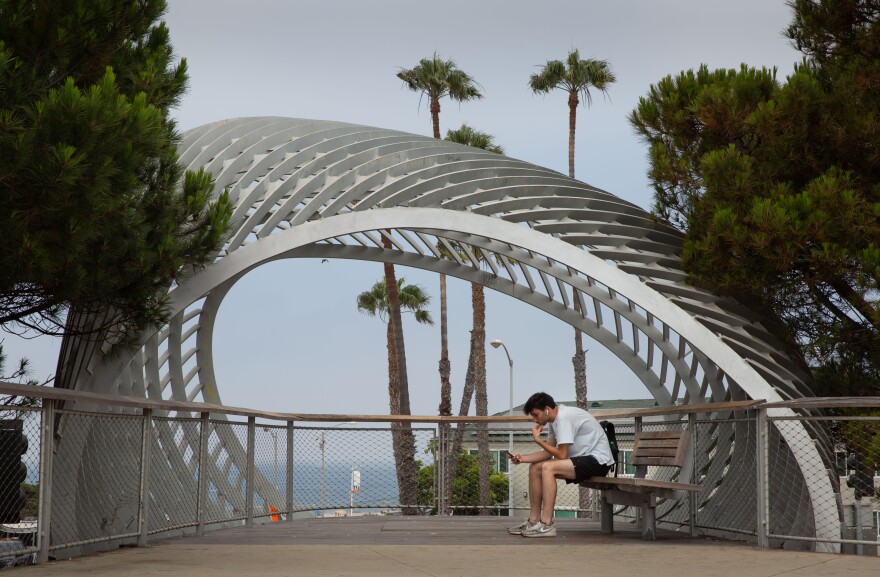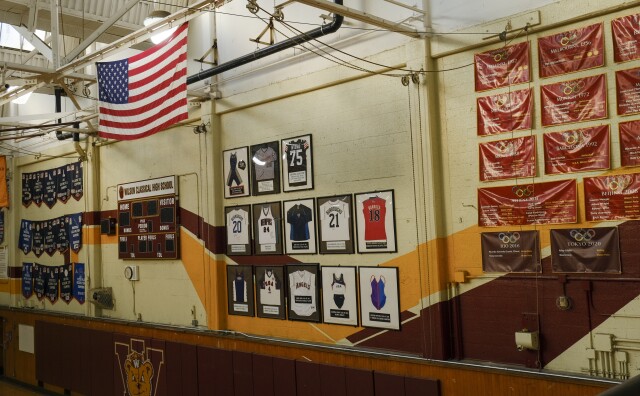If you attend an LAist event or listen to one of our podcasts, you’ll hear an acknowledgement that we operate within the homelands of the Gabrielino Tongva people. The tribe is one of many that has lived on and tended the land now called California.
“We recognize the painful history of displacement, settler colonialism, and erasure of the People, their language, including place names, and their sovereignty,” our statement reads.
We’ve also got resources for adults, but not a whole lot of kid-friendly ways to learn more about the original stewards of Southern California and today’s Indigenous communities.
“If parents really want to be diligent about it, they have to educate themselves first,” said Gregg Castro, the culture director for the Association of Ramaytush Ohlone, a Northern California tribe. “Then go along that same path with their kids.”
Castro, who is also T’rowt’raahl Salinan and Rumsien, suggested a locally produced documentary series “Tending the Wild,” which explores how Indigenous knowledge of plant and animal life has shaped the environment.
UCLA’s digital storytelling project Mapping Indigenous LA illuminates the lives of the original inhabitants of the Los Angeles Basin as well as those who have relocated and migrated here, including Pacific Islanders and the Indigenous diaspora of Latin America.
-
Terms like “settler colonialism” and “displacement” might not be in young kids’ vocabulary yet, but the concepts of fairness and exclusion become clear at a young age.
Once you’ve done the homework, here are a few family-friendly places to explore, but keep in mind, much of the area we now live in was once someone else’s home.
“Let the sun shine on you, let leaves fall on you,” Castro said. “Let flies and critters buzz around you and understand that you're only part of it, not the apex of it.”
Read Native stories
The Los Angeles Public Library curated Native American themed reading lists for children and teens.

LAist is also a fan of Waa’aka’: The Bird Who Fell in Love with the Sun. Cindi M. Alvitre tells the Tongva creation story with help from beautiful illustrations by Carly Lake. Publisher Heyday Books also has dozens of titles for adults by and about California’s indigenous peoples, from cookbooks to essay collections.
Take a field trip
The Fernandeño Tataviam Band of Mission Indians council of elders offers this guidance for visiting their homelands and we think it applies to any space you might explore on this list.
“Understand that the land beneath you contains thousands of years of our DNA. Be respectful of our Mother land and all her beings … We ask that you do not disturb our animal relatives, contaminate our sacred waters, or leave trash or belongings on our homelands during your visit.”

Autry Museum of the American West
The Museum’s collection includes more than 400,000 Indigenous objects. The museum also offers special programs for teachers and schools, and hosts performances by resident theater company Native Voices.
- Address: 4700 Western Heritage Way, Los Angeles, CA 90027
- Hours: Tuesday - Friday 10 a.m.– 4 p.m., Saturday - Sunday 10 a.m. – 5 p.m. Closed on several major holidays.
- Admission:
- Adults: $18
- Discounts: Seniors and students ($14), children ages 3-12 ($8)
- Free for: members; active-duty U.S. military and veterans; children age 2 and under; visitors on Tuesday and Wednesday afternoons (if you pre-register).
The museum was created after Chumash cultural sites were discovered in the area now known as Oakbrook Park in the 1980s. The center also hosts guided tours on the last Saturday of the month and workshops at varying times.
- Address: 3290 Lang Ranch Parkway, Thousand Oaks, CA 91362
- Hours: Saturday 10 a.m. - 4 p.m., Sunday 12 p.m. - 4 p.m.
- Admission: Adults: $8, Seniors, college students, active military, and children under 12: $5
-
Send suggestions for places in Southern California where families can learn more about Indigenous communities together to mdale@scpr.org.
University High School sits on the site of a Tongva village near a spring thought to be continuously inhabited for more than 8,000 years. The Gabrielino-Tongva Springs Foundation restored the site in recent years and maintains the cultural center there now.
- Address: 1439 S. Barrington Ave., Los Angeles, CA 90025
- Hours: First Saturday of the month from 10 a.m. - 3 p.m.
- Admission: Free

Los Encinos State Historic Park
The natural spring here once sustained the Chumash, Tongva, and Tataviam people who called the village of Siutcanga home. More than 70% of the Fernandeño Tataviam Band of Mission Indians descended from residents of the village. In 2023, California State Parks and the tribe deepened their collaboration to protect and provide education at sites within the tribe’s ancestral lands. The park also features Rancho El Encino’s historic adobe and blacksmith shop. Pro-tip: LAist outlined a 2.9 mile trek through Encino that includes a stop at the park!
- Address: 16756 Moorpark St., Encino, CA 91436
- Hours: Wednesday - Sunday 10 a.m. - 5 p.m. Closed on major holidays.
- Admission: Free
This community organization hosts presentations and nature walks throughout Southern California with the goal of raising Native American representation in the outdoors. Recent events included outings to Ernest E. Debs and San Gabriel River Parks.
- Locations and hours: Vary by event

Satwiwa Native American Indian Culture Center
Nearby Sycamore Canyon was part of a Chumash trade route for many years. The Culture Center hosts workshops, presentations, and art shows. You can also picnic and hike the nearby trails throughout the year.
- Address: Parking at N 34.1569 W -118.9733, Via Goleta and Lynn Road, Newbury Park, CA, 91320
- Hours: Saturday-Sunday, 9 a.m - 4 p.m.
- Admission: Free
Mojave Desert homesteader Howard Arden Edwards built the chalet-style building that now houses the museum in 1928. There are more than 3,000 objects that represent the American Indian cultures of the Great Basin. Can’t make the drive? There are also virtual museum tours hosted by tribal members with sign language interpretation.
- Address: 15701 East Ave. M Lancaster, CA 93535
- Hours: Saturday - Sunday 11 a.m. until 4 p.m., group tours Thursdays by reservation only
- Admission: $3
The Gabrielino-Tongva Tribe has a list of historical landmarks that includes trails, parks and monuments.

Willing to venture farther?
Visit Native California, a section of the state tourism bureau’s website, highlights destinations connected to tribal communities from the Central Coast’s proposed Chumash Heritage National Marine Sanctuary to Temalpakh Farm in Coachella.
“There are all these beautiful hidden secrets everywhere,” Agua Caliente Band of Cahuilla Indians public relations director Kate Anderson told Condé Nast Traveler. “All culture is not for tourism, but a lot is.”
Get lesson plan ideas
While California fourth graders have long-studied the state’s history (and once built sugar cube Mission models), the narrative was often incomplete.
There have been various efforts to expand lessons about California tribes. This year, lawmakers introduced legislation that would require teaching about mistreatment during the Spanish Mission and Gold Rush eras.
UCLA researchers created a series of questions to evaluate potential learning materials about American Indians including:
- Does the material speak solely in the past tense? If so, think about ways to speak to how American Indians are alive, present, and all around us.
- Does the material center European superiority and uncenter Indigenous science, technology and gifts given in the world?
- Does the material homogenize all Indians? Or does it speak to specific histories and cultural attributes?
California Indian History Curriculum Coalition
Videos and lesson plans created and vetted by educators, tribal scholars and native activists.
- LAist pick: This middle school lesson teaches students about primary and secondary sources (we love media literacy!) through the lens of the Miwok Indians, but could be adapted to talk about other communities.
Fernandeño Tataviam Band of Mission Indians Education and Cultural Learning Department
Enrollment in the nation’s workshops and camps is limited to Native American youth in L.A. County, but anyone can purchase this workbook that introduces the Fernandeño Tataviam language through stories, colors, animals, and numbers.
Early childhood reporter Elly Yu contributed to this story.










